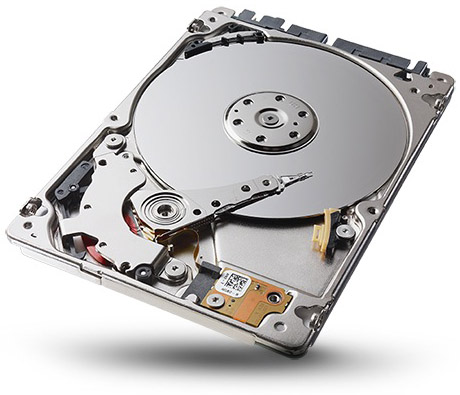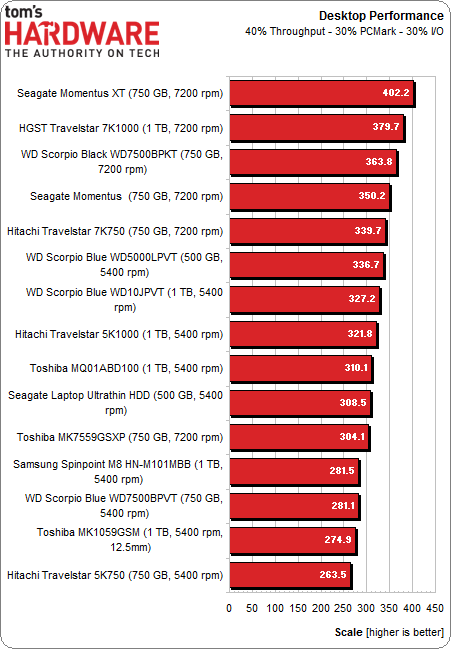Seagate Laptop Ultrathin HDD Review: 500 GB In 5 mm Of Space
When you look at it from the side, Seagate's Laptop Ultrathin HDD is almost easy to miss. Measuring just 5 mm tall, it’s one of the thinnest hard drives in existence. We got our hands on the 500 GB model to see if it can keep up with larger disks.
A Good Choice For Small Laptops And Ultrabooks
The Seagate Laptop Ultrathin HDD turns out to be a solid 2.5” hard drive with a SATA 6Gb/s interface. Its performance is good enough for the disk to stand in as a system drive in space-constrained mobile devices. However, as we might have guessed, and the benchmarks actually show, Seagate's ST500LT032 cannot compete with the fastest 7200 RPM models when it comes to an all-out drag race.
If we had to summarize the performance of Seagate's Laptop Ultrathin HDD in one word, it'd be average. It places somewhere in the middle of the field as we flip through our charts. The only notable exception is when we start digging into power consumption, where the Laptop Ultrathin HDD draws less power than most of the field. Again, this is what you want to see from a mobility-oriented hard drive.
Fortunately for Seagate, this drive isn't being marketed as a performance-oriented solution. Its main selling point is the fact that it's only 5 mm thick, instead of the 9.5 mm most of us are used to. This thin design lets the Laptop Ultrathin HDD fit in very shallow enclosures, while still facilitating 500 GB of capacity.
All of these points make the Laptop Ultrathin HDD a particularly interesting choice for Ultrabooks, especially as Intel chases prices down. There aren't many road warriors willing to sink an extra $300 into a large SSD after dropping $600 on a laptop. In contrast, the ST500LT032 sells to builders for under $100. Yes, there is a premium over more traditional 2.5" hard drives. But when the thin form factor is a must-have for fitment reasons, the extra cost is unavoidable, really.
Get Tom's Hardware's best news and in-depth reviews, straight to your inbox.
Current page: A Good Choice For Small Laptops And Ultrabooks
Prev Page Results: Power Consumption And Efficiency-
razor512 For the hard drive being benchmarked, is it possible for tomshardware to color the text to make them easier to find in the list?Reply
for example http://i.imgur.com/VXwTs6y.jpg
it only takes about 3 seconds to do (even faster if you are in the process of making the chart and not changing colors in post) -
Someone Somewhere ReplyIts main selling point is the fact that it's only 5 mm thick, instead of the 9.5"
Think you meant 9.5mm there.
At least it's not got proprietary connectors like the WD 5mm ones do. Think you need to add one of those to the benchmarks though - it's Seagate's biggest competition. -
slomo4sho This would be a good choice for a mITX build when you want budget storage to complement a SSD.Reply -
Someone Somewhere Not really; it'll cost significantly more per GB than a 9.5mm drive, but all the bays are fine with the thicker drives.Reply -
slomo4sho Reply11265059 said:Not really; it'll cost significantly more per GB than a 9.5mm drive, but all the bays are fine with the thicker drives.
Regular thickness drives are $60-80 and this one is mentioned to be under $100 with no price given for the consumer market. I wouldn't mind paying a small premium for a drive that utilizes 53% of the area of a 9.5mm drive. -
Someone Somewhere The thing is there's nothing you can do with the extra space; it's a couple of millimeters in the middle of an HDD cageReply -
XngXtuHl No point in 5 mm HDD, any laptop can install regular 9 mm HDDReply
More expensive, more slower
-
Flying-Q Please Tom's, get rid of the new format for pictures having the caption as an alpha-blended banner overlapping the bottom of the picture. This article's second picture, which attempts to illustrate the thinness of the new drive, is ruined by the new captioning method. Use some intelligence and put the caption UNDER the picture. This is the way that has worked for decades in both print and online. Why change something that works for a system that fails?Reply -
Someone Somewhere Reply11265453 said:No point in 5 mm HDD, any laptop can install regular 9 mm HDD
More expensive, more slower
Nope, ultrabooks often have 7mm slots or none, and soon I'd expect that to be 5mm.


